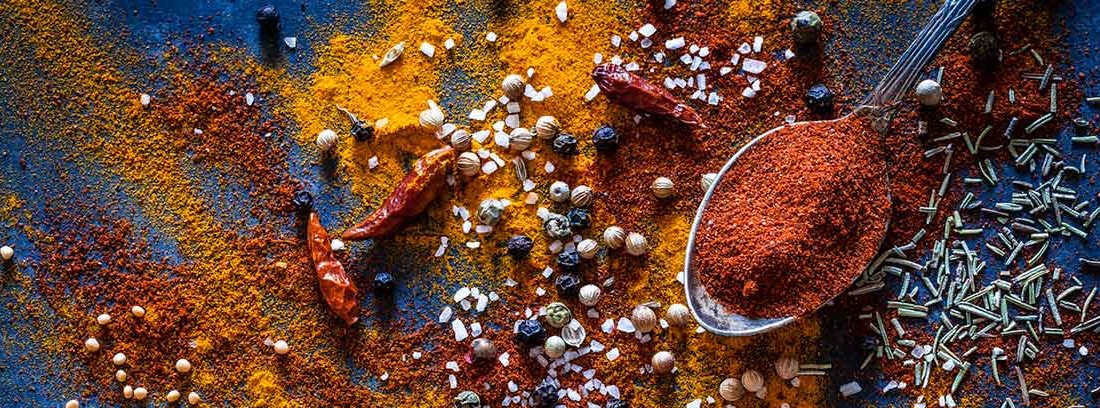Benefits and contraindications of eating spicy

The spicy, more than a flavor, is a feeling that is perceived through nociceptors (pain receptor nerve endings) when we eat a food rich in chemical compounds, among which the capsaicin, piperine, or allicin, present in foods such as chilli, chili peppers, peppers, pepper or garlic.
When the capsaicin receptor is stimulated, it responds by sending signals to the brain that are translated into the burning and stinging sensation on the oral mucosa. At the same time and in low doses, it produces an increase in the endorphin production, molecules responsible for the feeling of well-being.
When is it bad to eat spicy?
In healthy people, excessive consumption of spicy foods can damage the mucosa of the gastrointestinal tract causing nausea, vomiting, abdominal pain, ulcers, diarrhea and hemorrhoids. Likewise, some studies related the abuse long-term capsaicin with the.
Therefore, excessive consumption of spicy foods is especially contraindicated in people who suffer:
- Gastroduodenal ulcer
- Gastritis
- Irritable bowel syndrome
- Gastroesophageal reflux
- Hemorrhoids
- Liver problems
- Pregnant or lactating women
- In children under six years of age.
Benefits of eating spicy
- Stimulates gastric secretionsTherefore, the consumption of spicy foods in moderate amounts can help to promote digestion. For example, ginger supports digestion and prevents nausea and vomiting from pregnancy or chemotherapy.
- It is antibacterial and antiseptic (wasabi or ginger) so its use is useful in the prevention of toxiinfections in the preparation of raw fish that are very common in Japanese cuisine.
- It has an anti-inflammatory action at the arterial level and activates circulation. Using hot spices can be a good thing, a fact that can promote better control of high blood pressure.
- It is a natural pain reliever. Its pain-relieving action is due to the fact that it "tricks" the central nervous system by acting on pain receptors, which is why this substance also it is used in pharmacological formulas in pathologies such as psoriasis, rheumatoid arthritis or neuralgia. It is also studied to minimize sores and canker sores derived from cancer treatments, radiotherapy or chemotherapy.
- It is an activator of energy metabolism. Foods like mustard or pepper can activate one of the key enzymes in metabolism regulation and energy control. So it can help in the treatment of overweight, obesity and other metabolic diseases such as diabetes since it also modulates blood glucose levels.
Spicy foods and spices
In Spain, peppers containing capsaicin are also called chili, chilli, cayenne, or hot peppers, from which paprika (sweet or spicy) used in multiple recipes and as a preservative in sausages is also made.
Food such as garlic and onion: both contain a mixture of volatile sulfur compounds (alliin in the case of garlic and isoaliin in the case of onion) responsible for the itchy eyes produced when cutting one.
Apart from these spices, we can also highlight two spicy foods typical of Asian cuisine: wasabi and ginger.
- In the case of wasabi, the component that produces itching is the allyl isocyanate And, unlike capsaicin, its burning sensation diffuses into the nostrils, although its effect is much shorter and less irritating to the stomach.
- In the case of ginger The main components that give its characteristic spicy flavor are the gingerols, shogaols, zingerone and paradoxes, which also exert an antiseptic effect as they help fight bacteria resistant to antibiotics.
Can you get used to the spice?
Faced with high exposure to spicy foods, you may experience a capsaicin receptor resistance, thus increasing tolerance to the sensation of itching as occurs in countries like Mexico. While Europeans begin to suffer burning in foods with degrees of 5,000 SHU such as spicy padrón peppers, Mexicans are able to tolerate chili peppers of up to 20,000 SHU.
- The SHU is a standard scale to assess the degree of itching of a food. While in countries like Mexico they tolerate chili peppers of up to 20,000 SHU, Europeans began to suffer burning with foods of 5,000 SHU (such as padrón peppers).
- Chili, chilli, cayenne or hot peppers, as well as garlic, onion and also wasabi and ginger exert a spicy sensation when consumed.
- Among the effects of these spicy condiments is the digestive, especially ginger, which is even used to relieve nausea in pregnancy.
Judith Torrell
Diploma in Human Nutrition
Clinical Nutrition Specialist
(Updated at Apr 14 / 2024)